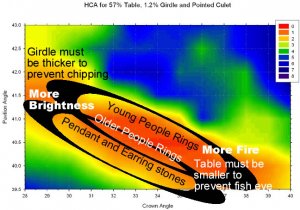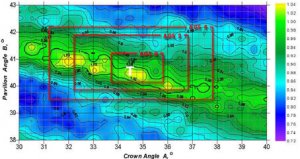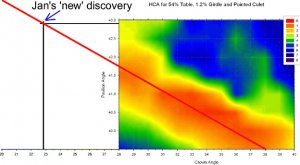aljdewey
Ideal_Rock
- Joined
- Nov 25, 2002
- Messages
- 9,170
Date: 11/10/2005 4:01:03 PM
Author: Rhino
This raises the question: First round of elimination for what? Ideal cuts? Please clarify.
I''ve done so multiple times already.....and in English, too....but ok. To eliminate diamonds with number relationships that suggest the diamond is likely to be a POOR performer. NOT to eliminate diamonds to the point where the only remaining diamonds will fit into AGS0 or GIAIdeal criteria.
Got a newsflash for ya.....some people are fine with AGS1 stones. Some like AGS2. While they aren''t AGS0, they still outperform a damn huge percentage of all available stones in the marketplace, right?
GET OFF the "ideal" terminology. That''s your problem. You keep wanting everyone else to conform to wanting the "creme de la creme"......not everyone wants that, and not everyone needs that. You keep wanting to limit discussion to ONLY AGS0 or GIA-Ideal possibilities.
You are arguing a MOOT point. NO ONE has said diamonds that score under 2 on the HCA will conform to current day AGS0 or GIAIdeal standards. Why, WHY, WHY do you keep arguing a point that NO ONE is contesting? Neither did anyone say that the HCA is a tool for determining ideal cuts *according to AGS0 or GIAIdeal* parameters. That doesn''t negate its usefulness FOR ITS STATED INTENDED PURPOSE......"to eliminate known poor performers". What remains after that elimination may include both stones of exceptional cut and just above average cut.......but they are NOT "known poor performers". Capice?Date: 11/10/2005 4:01:03 PM
Author: Rhino
Good analogy and good point. Answer: Enough of a difference that the 2 most conservative labs don''t consider many of these under HCA <2 combinations to be ideal. That''s enough for most consumers to know.Date: 11/9/2005 4:32:18 PM
Author: aljdewey
If you put one drop of red food coloring into an 4-oz glass of water, the color will change significantly....enough for me to notice. If you put one drop of red food coloring into *Lake Michigan*, there IS a measureable, infinitessimal alteration, but not one I can notice or appreciate. There is a difference between a ''measureable difference'' and an *appreciable difference*.
There''s been a lot of discussion recently about stones that score below 1 and how performance in such stones may not perform as well. HOW MUCH less well? Measureable or appreciable? If the difference means I''ll see 20% less light return in a majority of lighting conditions, that would potentially be meaningful to me....and likely appreciable to my eye.
If the difference means that I''ll only see 86.66667676767% light return instead of 86.66667676770% light return, should that matter? I don''t think so.
I will reiterate what I said in my last post. The HCA is not a tool for determining Ideal cuts.
Put another way.......a butter knife will never be called "the absolute sharpest instrument created by man", and it will never be able to cut a steel pipe in half. That doesn''t mean it won''t be useful FOR ITS INTENDED PURPOSE......to spread butter.
No, it''s not enough for consumers to know. The big piece you''re missing here is what the CONSUMER can perceive as a difference.Date: 11/10/2005 4:01:03 PM
Author: Rhino
Good analogy and good point. Answer: Enough of a difference that the 2 most conservative labs don''t consider many of these under HCA <2 combinations to be ideal. That''s enough for most consumers to know.
Rich Sherwood made a VERY sage statement a few months back: "What is true "by definition" is not necessarily observable "in practice". It makes no difference to a person that a bullet drops six inches at a thousand yards when it has been fired at him from six feet. The nuance of the physics escapes him."
Look, I''m sure AGS and GIA can readily spot the nuances between a VS1 and a VS2......but *I* can''t, and most Joe Average Consumers can''t. I''m sure they can readily appreciate minute differences in light performance......but *I* can''t, and most Joe Average Consumers can''t. People at labs spend YEARS looking at thousands of stones.......they are experts. OF COURSE they are more likely to see infinitessimal differences. But that DOESN''T mean AVERAGE consumers will see them.
I just spent FIVE HOURS at Whiteflash last month; so did Mara. Faced with a wide array of stones, *we* couldn''t tell which stones were H&A and which were just shy of it. We couldn''t tell which stones were shallow pavilion angles and which weren''t. We couldn''t tell which stones had crowns over 35 and which didn''t. We couldn''t even ascertain with certainty which stones were which colors when all lined up in the tray.
Now, it''s possible that Brian, you, Garry, Dave, every member of AGS and every member of GIA could appreciate *some* minute performance differences.......but most consumers won''t be able to see such subtle differences.
I''m not arguing with their opinions; I''m saying that their opinions don''t dictate how much distinction a CUSTOMER''S eyes WILL see. It only dictates what the LAB sees.Date: 11/10/2005 4:01:03 PM
Author: Rhino
This is AGS and GIA''s opinion so if you want to argue you can take it up with them.
The labs'' opinions is important because it narrows down what *pricing* is appropriate diamonds based on how close they come to the labs'' definitions of PERFECTION.
The CUSTOMER''S opinion is the one that determines how HE sees a diamond perform.
Thus, the labs'' opinion that my stone is an SI2 is meaningful because of its effect on the pricing of my stone. However, the fact that the lab designated my stone SI2 doesn''t mean it will look different to ME than an SI1 or a VS1......and it doesn''t. They can appreciate the difference, but I can''t.
I just don''t know how to explain this any clearer.




















300x240.png)